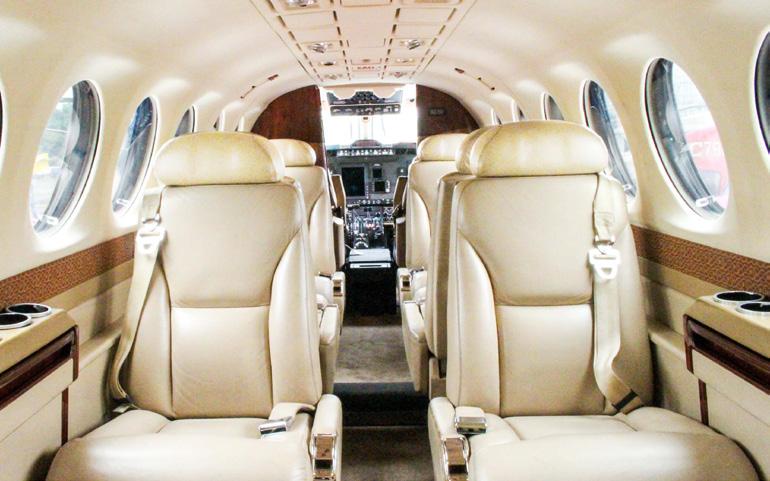
4 minute read
PG1: PACIFIC GLOBAL ONE AVIATION
The Gold Standard in Private Air Transport
It starts with the logo: a modern look with bold colors, solid lines, and aviation elements that speak of the company’s legacy and ambitions. The colors blue, gold, and white speak of the characters that PG1 embodies — trustworthiness, sophistication, and safety. The striking text leaves a strong impression, something customers will experience after flying with the company. Transitioning from a classic design, the updated badge signals a new era as the company heads into the horizon with the mission of becoming the gold standard in private air transport leading the industry in operational safety, service excellence, and customer satisfaction.
The aviation arm of PLDT, the Philippines’ largest integrated telecommunications company, Pacific Global One Aviation (PG1) expects the global air charter business to take off in the next three years as the impact of the COVID-19 pandemic plateaus.
As it charts its course into the next normal for air transport, it is guided by three values — safety, efficiency, and reliability.
PG1 is the only aircraft charter company in the Philippines that utilizes full-time two-pilot operations. On all flights, two aviators share the workload in the cockpit. This protects them from fatigue, allowing them to focus more on the mission, thus ensuring passengers’ safety. Efficiency means having three aircraft ready to service companies and individuals looking for a safer and more secure way of traveling that’s comfortable and tailored to their unique needs. The aircraft layouts can be configured according to the clients’ requirements.
PG1 only flies twin-engine aircraft. In case of mechanical emergencies, they can fly safely with a single working engine. The air assets routinely undergo maintenance and checks by experienced mechanics who have been certified and rated to service the fleet. This guarantees aircraft reliability, ready to be deployed as needed.

The Pacific Global One Aviation hangar in Pasay City houses two helicopters and one airplane. The Bell 429 can seat five passengers and can fly from Manila to as far as Laoag up north or Cebu down south. The AgustaWestland AW139 is a medium-sized helicopter that can carry eight passengers. It can reach most destinations in Luzon and the Visayas from Metro Manila. The model is also popular among governments and private charter operators around the world.
PG1 also operates a twin-engine turboprop, the King Air 350. The aircraft can accommodate eight passengers comfortably and can fly to all domestic points with airfields of at least a kilometer long. The plane can also ferry passengers to nearby Asian destinations such as Hong Kong, Singapore, and Japan.
When COVID-19 hampered commercial air travel and forced carriers to scale back operations, ground entire fleets, and explore uncharted territories, PG1 used its assets to fly special missions, transporting essential personnel and cargo to critical areas.
In November, one of the company’s choppers ferried Smart engineers and equipment to Catanduanes after the island province was cut off from the rest of the country in the wake of Super Typhoon Rolly. The flight mission was crucial in helping Smart quickly repair downed sites, becoming the first network to restore mobile services in the province within a week.
The company also flew healthcare personnel and medical supplies across the hospital network of Metro Pacific Investments Corp. all over the country to augment the workforce and replenish stocks in critical locations.
Pacific Global One Aviation is expanding its menu offerings. Aside from ferrying corporate clients and individuals with ultra-high-networth, the company can also fly cargo, perform medical evacuations, and lease out space at its hangar for clients who wish to park their own aircraft.
“Pacific Global One Aviation is sending a clear message that the company is constantly evolving, striving for perfection, and positioning itself ahead of the competition. We will be working on mutually beneficial partnerships and collaborations with companies whose target market also aligns with PG1,” said general manager Arnold E. Picar. “We have been getting a lot of inquiries, especially from corporations, on our air transport services. Companies are looking for a safer way to travel as the government gradually eases restrictions and opens up the economy,” said Leo A. Gonzales, PG1 OICpresident.
This is validated by a Business Wire report, citing the impact analysis by global technology and market research firm Technavio. The report states that the global air charter services market will grow by more than USD 7-billion through 2024. The biggest driver will be the passenger segment but there’s a growing demand for cargo services as well.
The report further says that, in a worst-case scenario, the impact of the pandemic is expected to normalize in the first quarter of 2022. The global health crisis crippled air travel, hitting carriers and air taxi operators all over the world in 2020.











